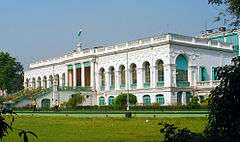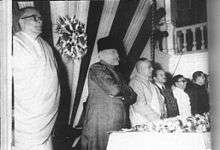National Library of India
 National Library | |
| Country | India |
|---|---|
| Type | National library |
| Established |
30 January 1903 as Imperial Library 1 February 1953 as National Library of India |
| Location | Belvedere Estate, Kolkata, West Bengal |
| Other information | |
| Director | Arun Kumar Chakraborty[1] |
| Website | nationallibrary.gov.in |
The National Library on the Belvedere Estate in Alipore, Kolkata,[2] is the largest library in India by volume, 14th in the list of largest libraries, and India's library of public record.[3][4][5] It is under the Department of Culture, Ministry of Tourism & Culture, Government of India. The library is designated to collect, disseminate and preserve printed material produced in India. The library is situated on the scenic 30-acre (12 ha) Belvedere Estate. It is the largest in India with a collection in excess of 2.2 million books.[6] Before independence, it was the official residence of Lt. Governor of Bengal.
The National Library of India is the county’s largest library and the library of public record. The library "operates under the national government’s Department of Culture and is designated to collect, disseminate, and preserve all printed material produced in India, and all foreign works published about the country—where ‘every work about India…can be seen and read’" (Murray, 2009). The National Library is a result of the merging of the public library with the Imperial Library—several government libraries. The National Library (1953), then the Imperial Library housed several foreign (British) and Indian titles and was open to the public. Of further note, the National Library of India collects book, periodicals, and titles in "virtually all the Indian languages, with Hindi, Kashmiri, Punjab, Sindhi, Telugu, and Urdu" maintaining the largest stacks (Murray, 2009). The Special Collections in the National Library of India house at least fifteen languages including "Assamese, Bengali, Gujarati…and Tamil with many rare works (Murray, 2009). The Hindi department has books that date back all the way to the nineteenth century and the first ever books printed in that language. The collections break down and consist of 86,000 maps and 3,200 manuscripts.[7]
History
The Calcutta Public Library
The history of the National Library began with the formation of the Calcutta Public Library in 1836.
That was a non-governmental institution and was run on a proprietary basis. People contributing ₹300 (US$4.20) in subscription became the proprietors. Prince Dwarkanath Tagore was the first proprietor of that Library. ₹ 300 at that time was a significant amount, so poor students and others were allowed free use of the library for some period of time.
Lord Metcalfe, the Governor General at that time, transferred 4,675 volumes from the library of the College of Fort William, Kolkata to the Calcutta Public Library. This and donations of books from individuals formed the nucleus of the library.
Both Indian and foreign books, especially British, were purchased for the library. Donations were regularly made by individuals as well as by the government.
The Calcutta Public Library had a unique position as the first public library in this part of the world. Such a well-organized and efficiently run library was rare even in Europe during the first half of the 19th century.
Due to the efforts of the Calcutta Public Library, the present National Library has many extremely rare books and journals in its collection.
The Imperial Library
The Imperial Library was formed in 1891 by combining a number of Secretariat libraries in Calcutta. Of those, the most important and interesting was the library of the Home Department, which contained many books formerly belonging to the library of East India College, Fort William and the library of the East India Board in London. But the use of the library was restricted to the superior officers of the Government.[8]Sir Ashutosh Mukherjee was appointed as the president of imperial library council(1910) to which he donated his personal collection of 80,000 books arranged in a separate section.
Amalgamation of CPL and Imperial Library
In 1903, Lord Curzon of Kedleston, the Viceroy of India, conceived the idea of opening a library for the use of the public.
He noticed both the libraries—Imperial Library and Calcutta Public Library—were under-utilized for the want of facilities or restrictions. He decided to amalgamate the rich collection of both of these libraries.
The new amalgamated library, called Imperial Library, was formally opened to the public on 30 January 1903 at Metcalfe Hall, Kolkata. Metcalfe Hall had earlier been the home of the Governor-General; Wellington, Cornwallis and Warren Hastings had lived in the building, and the last-named had fought a duel with a member of his governing committee on its grounds.
The Gazette of London reported, "It is intended that it should be a library of reference, a working place for students and a repository of material for the future historians of India, in which, so far as possible, every work written about India, at any time, can be seen and read."
Declaring the Imperial Library as the National Library

After the independence the Government of India changed the name of the Imperial Library as the National Library, and the collection was shifted from The Esplanade to the present Belvedere Estate. On 1 February 1953 the National Library was opened to the public.
Discovery of hidden chamber
In 2010, the Ministry of Culture, the owner of the library, decided to get the library building restored by the Archaeological Survey of India (ASI). While taking stock of the library building, the conservation engineers discovered a previously unknown room. The secret ground-floor room, about 1000 sq. ft. in size, seems to have no opening of any kind.[9]
The ASI archaeologists tried to search the first floor area (that forms the ceiling of the room) for a trap door, but found nothing. Since the building is of historical and cultural importance, ASI has decided to bore a hole through the wall instead of breaking it. There are speculations about the room being a punishment room used by Warren Hastings and other British officials, or a place to store treasure.[9]
In 2011, the researchers announced that the room was filled entirely with mud, probably in an effort to stabilize the building.[10]
Visiting
The National Library is located on Belvedere Road in Alipore, Calcutta. It is open between 9 am and 8 pm on all working days and between 9.30 am and 6.00 pm on Saturdays, Sundays and Government of India holidays.[2]It remains closed on three national holidays, 26 January *(Republic Day), 15 August (Independence Day) and 2 October (Birthday of Mahatma Gandhi).
Access to the National Library main reading room (Bhasha Bhavan) is strictly controlled. The visitors need to have an approved Reader's pass to reading hall. For that they need to fill in an application form (available on the National Library website) and get it attested by a Government Gazetted officer. The reader's passes are issued only between 11.00 am and 1.00 pm, and between 3.00 pm and 4.00 pm, from Monday to Friday, excluding a string of National and State holiday.
Library statistics
- Over 2,270,000 books
- Over 86,000 maps
- Over 3,200 manuscripts
- Over 45 kilometers of shelf space
- Reading rooms can accommodate over 550 people
References
- ↑ "Administration of the National Library".
- 1 2 "Useful Information". National Library.
- ↑ "Largest Library in India - National Library Kolkata".
- ↑ "Progress To Be Made In National Library, Kolkata".
- ↑ "Archived copy". Archived from the original on 7 April 2014. Retrieved 1 April 2014.
- ↑ "Archived copy". Archived from the original on 7 April 2014. Retrieved 1 April 2014.
- ↑ Murray, Stuart (2009). The Library an Illustrated History. Chicago: ALA Editions. p. 283.
|access-date=requires|url=(help) - ↑ http://www.nationallibrary.gov.in/nat_lib_stat/history.html
- 1 2 Jhimli Mukherjee Pandey (22 November 2010). "Secret chamber in National Library". The Times of India. Retrieved 20 November 2010.
- ↑ Debaleena Sengupta (22 May 2011). "Room With No View". Business Standard. Retrieved 22 May 2011.
External links
| Wikimedia Commons has media related to National Library of India. |
Coordinates: 22°31′59″N 88°20′00″E / 22.53306°N 88.33333°E